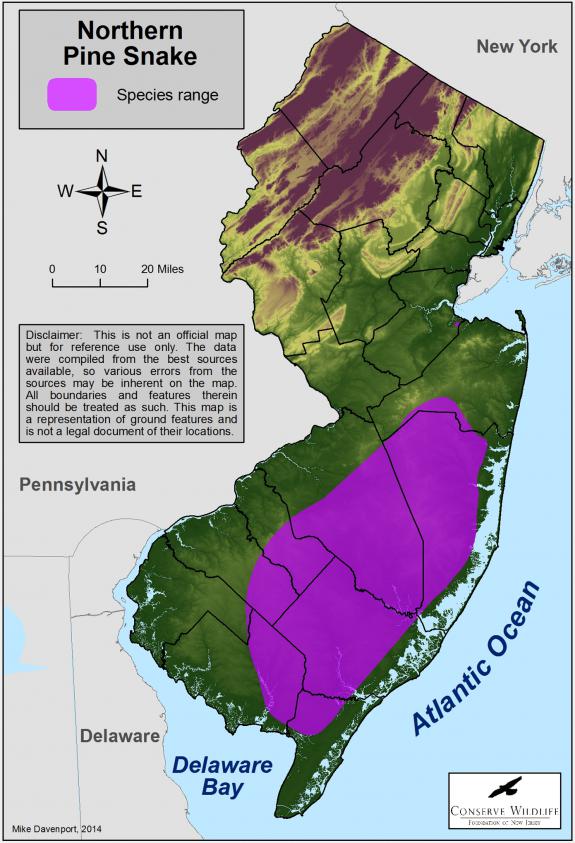Pituophis melanoleucus melanoleucus
Type: reptile
Status: threatened
Species Guide
Northern pine snake
Pituophis melanoleucus melanoleucus
Species Type: reptile
Conservation Status: threatened
Identification
The Northern Pine Snake is a long (48”-100”) snake with a slightly pointed snout. Ground color is white, gray, or cream, marked with black or dark brown blotches. The blotches are less distinct at the front half of the snake, and become more clearly delineated towards the tail end. In addition, the blotches are browner towards the tail. They have keeled scales and a single anal plate. The northern sine snake will hiss and defend itself vigorously when threatened. Northern pine snakes are typically ground dwellers and rarely climb vegetation. They are secretive and can burrow underground, making them hard to detect even in locations where they are common.

Distribution & Habitat
In New Jersey, the pine snake occurs exclusively within the Pinelands habitats of the outer coastal plain. Pine snakes nearly always occupy dry upland forests dominated by pines. Pine snakes require forest openings, with level, well-drained sandy soils and little shrub cover for nesting and hibernation sites. Human and natural disturbances such as agriculture, forestry, and fire are probably involved in creating the types of forest openings important for nesting and basking. The New Jersey population is disjunct and distant from other parts of this species’ range.
Diet
Adult pine snakes feed on a variety of rodents and other small mammals as well as birds and their eggs. Younger snakes prey upon small mammals, lizards and insects.
Life Cycle
Female pine snakes lay eggs in burrows dug in sandy clearings with high sun exposure. The large eggs are usually laid between mid-June and mid-July. An average of 2 to 12 eggs is laid per clutch. The eggs incubate a minimum of 60 days before hatching. Hatchling pine snakes range in length from 10.5” to 15” and may stay close to the nest until their first shed. Females often return to the same nest to lay their eggs each year. In New Jersey, this species is active from April to October and spends winters in underground dens.
Current Threats, Status, and Conservation
Northern pine snakes face a variety of threats in New Jersey. Habitat loss and alteration are the greatest threats to this in New Jersey. However, illegal collecting and off-road recreational vehicle use also have harmful effects on pine snakes.
The development of Pinelands habitats leads to a loss of pine-oak forest habitat and an increase in human encounters with pine snakes. Too often, such encounters prove fatal to these snakes, and reports of pine snake road kills are common. Some forestry practices may also have negative impacts on pine snakes. For example, forestry practices that favor oak-dominated systems with closed canopies or dense shrub layers probably decrease the amount of suitable pine snake habitat in an area.
References
Beans, B. E. and Niles, L. 2003. Endangered and Threatened Wildlife of New Jersey.
Scientific Classification
- Kingdom: Animalia
- Phylum: Chordata
- Class: Reptilia
- Order: Squamata
- Family: Colubridae
- Genus: Pituophis
- Species: P. melanoleucus melanoleucus